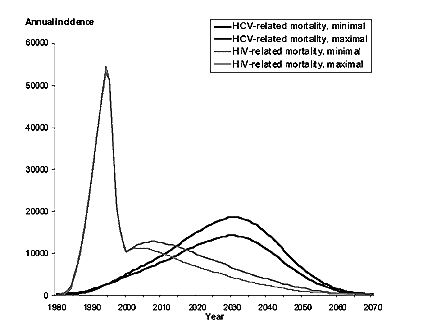 |
 |
 |
| |
COMPARING THE PUBLIC HEALTH BURDEN OF CHRONIC HEPATITIS C AND HIV INFECTION IN UNITED STATES
|
| |
| |
54th AASLD Boston, MA
Oct 24-28, 2003
Poster abstract #552
Sylvie Deuffic-Burban, INSERM U444, Paris, France; John B Wong, Tufts-New England Medical Center, Boston, MA; Thierry Poynard, Groupe Hospitalier Pitie Salpetriere, Paris, France
In the US, hepatitis C virus (HCV) is perhaps four times more common than human immunodeficiency virus (HIV). Prior to effective therapy for HIV, AIDS-related mortality exceeded that from liver disease, but the advent of highly active anti-retroviral therapy (HAART) has greatly improved HIV survival and reduced AIDS-related mortality. Many HIV-infected individuals have been diagnosed and treated but HCV remains mostly undiagnosed and untreated. Projecting the future health burden of these two epidemics may help health policymakers plan their responses.
The pupose of the study is to compare the projected future disease burden (incidence and mortality) related to HCV and to HIV in the US.
We applied the back calculation method to develop mathematical models of the HIV and the HCV epidemic in the US and have incorporated antiviral treatment into these estimates (proportion treated and their likely response; for HCV these estimates were only up until 1999 and did not consider the combination of peginterferon and ribavirin). These models were based on US epidemiologic data regarding prevalence, incidence of infection, age and gender of incident cases, AIDS, hepatocellular mortality and general population mortality from the CDC, WHO and literature data.
We first applied the back calculation method to develop separate HIV and HCV models. Logistic and time-dependent lognormal model parameters were adjusted until the models resulted in the best fit or match to the reported past incidence of these two infections up to 1998. We then projected future HIV and HCV-related mortality until 2070.
In the HIV model, the time from infection to AIDS (AIDS incubation period) is assumed to be 8 years in the absence of anti-retroviral treatment or during the mono-therapy period (before 1995), 10 years during dual-therapy period (1995-6) and 20 years during HAART or triple-therapy period since 1996. These estimates were based on HIV-seropositive subjects in French hospitals.
RESULTS
Based on the HCV backcalculation model, the HCV epidemic peaked with a maximum annual HCV incidence in 1984 at 149,000-224,000 new infections and then fell to about 33,000-46,000 in 1998. Based on the HIV backcalculation model, HIV incidence reached its maximum in 1989 at 132,000-162,000 new infections and then declined to 38,000-49,000 in 1995, before rising again. Mortality related to HCV (death from liver failure or hepatocellular carcinoma) rose from about 3,800-4,200 in 1998 to peak at about 14,000-19,000 in 2030. For comparison, observed HIV-related mortality was 16,000 in 1998 and projected to be 4,200-6,700 estimated for 2030.
With the availability of effective HAART for HIV infection, mortality from HIV appears to have declined substantially. The stability of that decline will depend on epidemiologic trends and the rate of development of HAART resistance. Our model projections for hepatitis C are consistent with three other US projections that all suggest that mortality and the public health burden of HCV will rise over the next 30 years. |
| |
| |
 |
|
| |
|
 |
 |
|
|